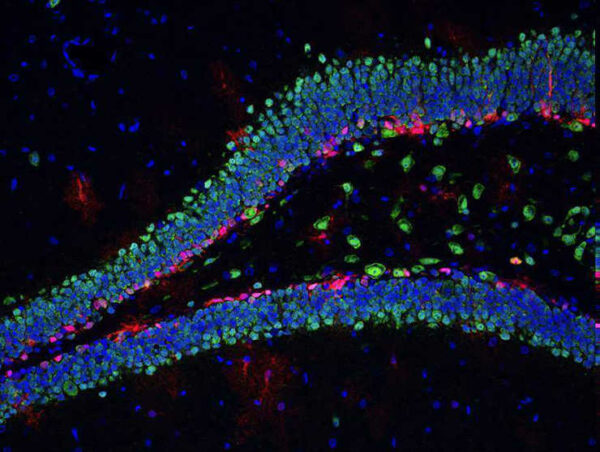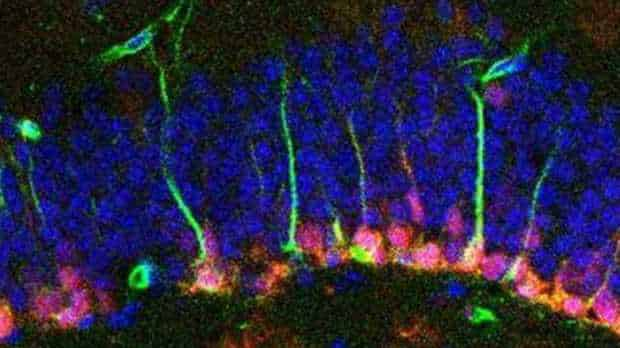One of the first studies to unravel the genetic activity inside individual growing brain cells has been published recently. University of Wisconsin-Madison neuroscientist Xinyu Zhao has identified the genetic mechanism that causes maturation in a young nerve cell.
The cells being studied came from the hippocampus, a memory-related structure that is the only place in a mammal’s brain where new neurons can form throughout life.
Newly formed brain cells were discovered in the hippocampus more than 20 years ago. Since that time, scientists have identified the many roles they play in learning and memory.
However, mystery continues to surround the genetic controls that regulate the formation of the delicate structures and the chemicals necessary for neural communication, Zhao says.
Zhao worked In the 1990s as a postdoctoral fellow with Fred Gage at the Salk Institute for Biological Studies. The Institute was the site of groundbreaking discoveries on the formation of new neurons, known as postnatal neurogenesis, in the hippocampus.
Until the discovery of this adult neurogenesis, scientists thought that the brain essentially had to make do with the supply of neurons it acquired at birth. The limited supply of new neurons that grows in the hippocampus throughout the lifespan has a role in memory, and perhaps in recovery from degenerative disease.
Growing Brain Cells A Window On Brain Development
Zhao, now a professor of neuroscience at UW-Madison, has been probing the adult neurogenesis puzzle for most of her scientific career.
“While trying to understand the mechanism that regulates adult neurogenesis, I am also using adult neurogenesis as a model to study brain development and developmental diseases,” she says. “In lab animals, adult neurogenesis provides a source of cells that can show us how a neural stem cell develops into a fully-formed neuron.”
As might be expected for an organ as fantastically complex as the brain,
“neurons come in many varieties,” Zhao says, “and their genetic activity changes as they mature. To really understand this process, we need to know which genes are active, and when.”
Under study, a group of neurons might average out, which would mask key distinctions at different stages of growing brain cells.
“When you look at individual cells you can see a lot more information than you can in groups,” Zhao says.
Types of Neurons
Imagine describing the monarch butterfly
The situation in growing brain cells is even more confusing, Zhao says.
“There are so many different types of neurons, and the stage of development is also critical for understanding the development process.”
The technology to leap this hurdle, which can isolate individual neurons so their genes can be extracted, was first used on brain cells in 2014.

Credit: Yu Gao, Waisman Center, University of Wisconsin–Madison
Taking young neurons from the hippocampus of adult mice, postdoctoral fellows Yu Gao and Feifei Wang (now a member of the faculty at Fudan University in Shanghai) isolated 84 single neurons that had differentiated from neural stem cells at least three days before—meaning they had started, but not completed, the transformation to a mature neuron.
Once the data on gene activation was assembled, Brian Eisinger, another postdoctoral fellow with expertise in bioinformatics, performed intensive analysis on the rising and falling activity of thousands of genes.
Brain Cell Growth Stages
The gene activation profiles of individual cells revealed that the growing brain cells go through four stages. However, the results also revealed hints about the origin of common neurological conditions.
First, the most active genes during the stem cell phase overlapped significantly with genes implicated in Alzheimer’s and Parkinson’s diseases.
“It surprised us to see that genes associated with the stem cell life stage are highly represented in these neurodegenerative diseases,” says Zhao. “We do not know the significance, but it’s possible that these conditions are more related to stem cell impairment than we thought.”
Second, the gene exhibiting increased activity during neuron maturation overlapped with genes associated with autism. That picture is complex, Zhao acknowledges, as thousands of genes are affected in some way in autism.
“This was an exploratory analysis that may open a new window on understanding complex disorders like autism,” Zhao says. “Imagine if you unexpectedly saw a mountain lion’s paw print in the forest. Now you would wonder if the lion explained a sudden shortfall of deer in the forest, but you would not know until you looked further.”
Junior biochemistry student Laurel Kelnhofer and graduate student Emily Jobe also contributed to the study, published today in the journal Cerebral Cortex.
Although papers using single-cell analysis of mammalian neurons have begun to appear in the last year, they focused on large populations of neurons, Zhao says.
“Ours is the first single-cell analysis in adult-born new neurons. Our challenge was that these are scarce, so we had to work hard to optimize our cell isolation procedure.”
Reference:
- Yu Gao, Feifei Wang, Brian E. Eisinger, Laurel E. Kelnhofer, Emily M. Jobe, and Xinyu Zhao
Integrative Single-Cell Transcriptomics Reveals Molecular Networks Defining Neuronal Maturation During Postnatal Neurogenesis
Cereb. Cortex (2016) doi:10.1093/cercor/bhw040
Top Illustration: The V-shaped blue structure is part of the adult hippocampus, where new brain cells are produced throughout life in most mammals, including humans. Red: new, immature neurons. Green: mature neurons. Credit: Yu Gao, Waisman Center, University of Wisconsin-Madison
Last Updated on October 5, 2023
